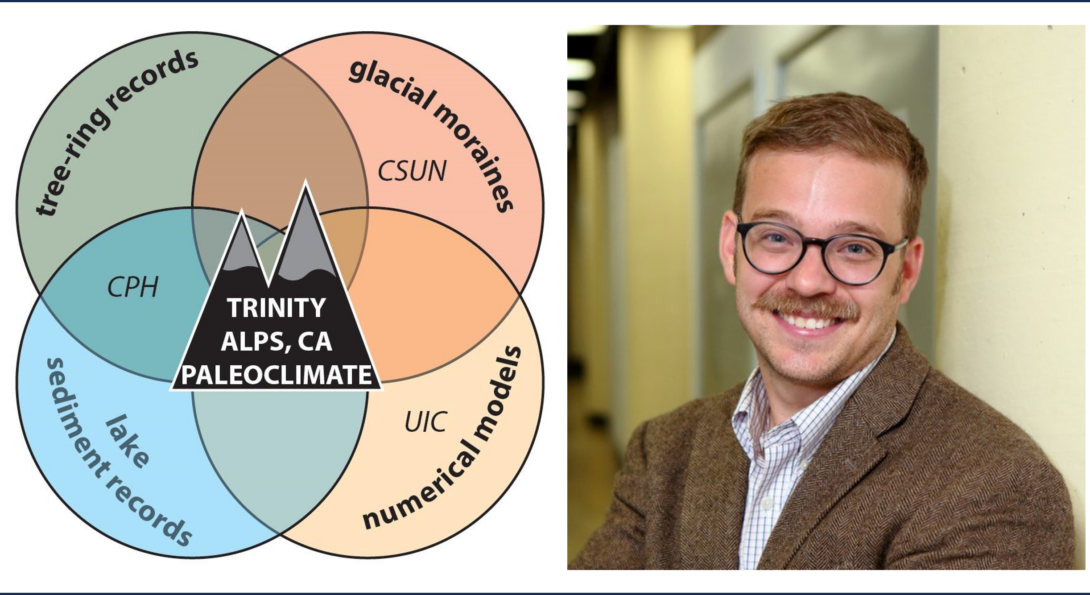Prof. Andrew Malone awarded NSF grant to study the glacial record from the Trinity Alps in California

Introduction
Through a recent award from the National Science Foundation, Prof. Andrew Malone will be able to expand his research of climate change through the glacial record. Along with collaborators from California State University, Northridge and California Polytechnic University, Humboldt, Andrew will be leading a research study that combines observational and computational techniques to investigate glacier behavior in the Trinity Alps in California. Specifically, Andrew will focus on using computational and numerical models that will involve simulating glaciers and analyzing output from state-of-the-art climate models that have been run to reconstruct climate changes over the past 20,000 years.
Question: Your study focuses on the Trinity Alps of the Klamath Mountains. Can you tell us more about this unique region and how it might be critical to learning more about climate change?
Andrew Malone: The Trinty Alps of the Klamath Mountains are located in Northern California, about 90 miles from the Pacific Ocean. It’s a unique setting for glaciers in the continental United States. The region receives more precipitation than other mountain ranges home to glaciers in the continental United States, such as the Rocky Mountains or Sierra Nevadas. Also, glaciers in the Trinty Alps were at lower elevations. We hypothesize this was possible because they received more precipitation. The unique setting also means its glaciers may have responded differently to climate changes than glaciers in other mountain ranges. Reconstructing the glacial history in the Trinty Alps over the past 20,000 years may provide new insights into the timing and types of climate changes that affected the region. Also, the region has minimal glacial records, so this glacial history will help paint a richer picture of past climate changes.
Question: What types of data and measurements will be used in your study? Will you have to travel to the glacier to collect data?
Andrew Malone: This study will combine multiple types of climate records and output from computer models (see figure above). Landscape features left behind by glaciers, such as moraines and glacial erratics, can tell us where the glaciers used to be, and we can determine when the features formed. Sediments deposited on the bottom of lakes can identify changes in the size of the glaciers as well as broader environmental conditions. Tree rings can help us determine the timing and types of past glacial and environmental changes. The UIC component will focus on computer models that simulate how glaciers flow and gain/lose mass allow us to constrain how much climate change occurred during past glacial changes. Climate model simulations that reconstruct conditions over the past 20,000 years can highlight climate change mechanisms that explain our glacier reconstructions. By combining multiple types of records, we can gain a richer picture of the environmental changes that occurred in the region. Through numerical models, we can quantify these changes and evaluate their mechanisms.
This summer, my colleagues from the California State University Northridge (CSUN) and Cal Poly Humbolt (CPH) and I will spend almost two weeks in the Trinty Alps. We will map landscape features in the area and collect samples to determine when they formed. We will collect sediments from the bottom of lakes using inflatable rafts and equipment that can extract sediment cores. We will also collect samples from trees to analyze variations in the width and chemistry of the tree rings. Back at UIC, I will spend time running computer-model experiments and analyzing output from climate models. There are opportunities – both volunteer and paid – for UIC undergraduate student involvement in this on-campus research using computer modeling. If you are interested, please contact me through my email (amalone@uic.edu).
Question: A large component of the project seems to be focused on student experiences. Can you describe more about what you hope students will gain from a field trip experience to the Central Valley in California?
Andrew Malone: My colleagues and I are quite excited about the opportunities for students that this grant provides. I look forward to supporting two UIC undergraduate students each summer in a funded 9-week summer research experience. I also plan to involve undergraduate students in this research throughout the school year. My colleagues at the California State University Northridge (CSUN), Dr. Richard Heermance, and Cal Poly Humbolt (CPH), Dr. Laura Levy and Dr. Rosemary Sherriff, will have graduate students assist them in the field. They will also have graduate and undergraduate students involved in analyzing the samples brought back to the lab. We look forward to helping train the next generation of Earth and environmental scientists through the opportunities this grant provides.
We also hope this grant can introduce more students to the Earth and environmental sciences. Given the recent megadrought in California and the expected future droughts, studying glaciers, which are an important source of freshwater in California, is timely and relevant. We expect undergraduate students will be interested in learning more about their water resources and how climate change affects them. To introduce students to water resources in California, Dr. Heermance (CSUN) and Dr. Levy (CPH) will co-lead a 5-day, field-based trip in the summer of 2025 and the summer of 2026. The trip will start in the Trinty Alps, follow the Sacramento River downstream, and culminate at the Sacramento River delta. They will also visit the California State Water Board. These trips will bring together students from the northern (CPH) and southern (CSUN) parts of California, foster collaborations, and introduce them to pressing questions and key techniques in the Earth and environmental sciences.